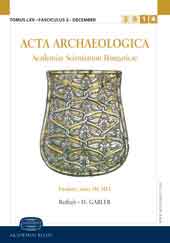Shifting populations in Late Antiquity. Germanic populations, nomads and the transformation of the Pannonian limes
Shifting populations in Late Antiquity. Germanic populations, nomads and the transformation of the Pannonian limes
Author(s): Paolo De VingoSubject(s): Ethnohistory, Social history, Ancient World, 6th to 12th Centuries
Published by: Akadémiai Kiadó
Keywords: limes; Roman Empire; Germanic populations; nomads;
Summary/Abstract: The inhabitants of the steppes around the Black Sea and the nearby areas of the wooded steppe must be recognised as having played a special role in the events that occurred during the transition from Late Antiquity to the Early Middle Ages. These populations were known not only by their peculiar living conditions but also various cultural models, even though the pastoral nature of their economy and the continuous movements related to it were of fundamental importance. The steppe was also an extensive link that facilitated contacts with the nomads present beyond the southern course of the Volga and Ural rivers, in the vast territories of the Central Asian zones up to the border with China. Toward the end of Late Antiquity, the ethnic make-up of the inhabitants of those territories changed. The Indo-European nomads were replaced by the groups of Turks-Mongols that arrived in subsequent waves from the Asian steppes. These included the Huns, who in 375 had destroyed the state of the Goths on the Black Sea and, having settled after 420 in the woods and plains crossed by the river Tisza, continued to go beyond the Pannonian limes to strike the areas closer to the border. The intensity of these incursions increased after 434 when Attila unified the nomadic tribes under his command, creating a vast empire of the steppe whose centre was located between the Tisza and the middle region of the Danube. The Huns also cooperated with the subjugated communities, first and foremost the rest of the Goths, Gepids and other Germans who had remained in their residential areas, but also the Alani and the Jazigs. It was only after the defeat of 451 on the Catalaunian Plains, the failed Italian expedition of 452 and the sudden death of Attila in 453 that the Hun Empire completely fell apart. The final blow was struck on the Nedao River in southern Pannonia by the forces united under the command of the Gepids in 454 or 455. What triggered a new shift of Germanic populations, considered the final phase of the period of the “Great Migrations” of peoples, was the ingress of the Langobards into Italy in 568. This alliance of Germanic tribes had appeared at the beginning of the 6th century on the shores of the Danube and, taking full advantage of the collapse of that sector of the limes in 526, began to occupy Pannonia. In the face of the danger represented by the Avars, and the new nomads who began to occupy the entire plain crossed by the Tisza, the Langobards decided to abandon Pannonia, leaving it to the Avars on the basis of a peace treaty.
Journal: Acta Archaeologica Academiae Scientiarum Hungaricae
- Issue Year: 61/2010
- Issue No: 1
- Page Range: 261-282
- Page Count: 22
- Language: English
- Content File-PDF

